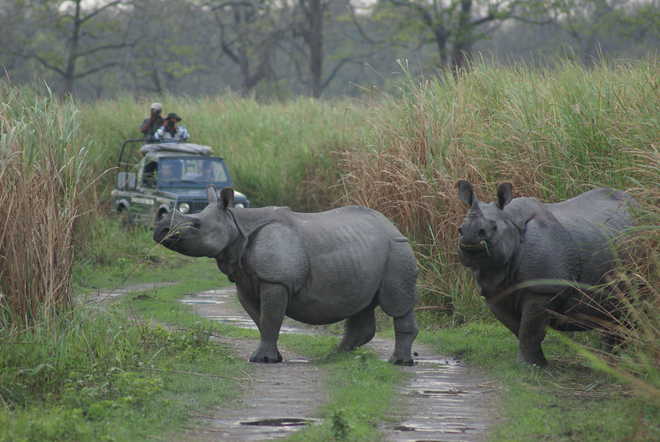
Two rhinos cross a motorable road
Hugh & Colleen Gantzer
Every year, the Brahmaputra, ‘The Son of the Creator’, re-creates this fabulous National Park. The silt-heavy waters of the great river, as rich and thick as coffee-and-cream, spread fertile soil that it carries from the Himalayas across the floodplains of Assam’s Kaziranga. It is silver-grey sandy-loam and many of the natives of the park love wallowing in it because a layer of it on their hides wards off insects. When early travellers saw the most unusual of the Park’s creatures, they took back wondrous tales which, in the telling and re-telling, became the legendary silver-skinned Unicorns with a single horn in the centre of their heads: which is what “un-corn” means.
These denizens of the Park have adapted their lives to the yearly flow of the river. The experienced ones just move into the highlands of the fringing Mikir Hills. When the renewing floods subside, and the riverine plains are lush and green and misty and cool, they move back. That is when we followed them in a jeep with an alert driver and a keen-eyed guide.
Then, with a fine film of sweat and moisture cooling us in this loam-scented Jurassic atmosphere, the inhabitants began to appear. Appropriately, it was a mottled-skinned Monitor Lizard, almost invisible in the leaf-litter. It flicked its tongue, smelling and tasting us at the same time as its monstrous ancestors would have done millions of years ago. We were too large for a snack, so it slithered into the undergrowth and vanished. “It’s probably looking for eggs,” our guide said, “or little chicks”. A short drive further we spotted a flamboyantly scarlet-and yellow jungle cock and his dowdy brown hen. Those feathered ancestors of all domesticated fowls were busy recycling the droppings of elephants. A little later we saw a family of these great pachyderms. An elephant herd is a matriarchy led by an alpha female. They communicate by sub-sonic rumbles heard, over long distances, through the soles of their feet. We were not a threat. Slowly, ponderously, they ambled away, flapping their temperature-adjusting fan-like ears.
After that the sightings came even thicker and faster. A little hog deer stared at us from the bushes, his timorous wife peering at us through a veil of grass. They form faithful, closely-bonded couples for most of the year. In the rutting season, however, they get involved in aggressive mating rituals much like hyped-up swingers in a disco. And for the same purpose. Next, in the mist-softened distance, we spotted a brown mass of marsh-wallowing swamp deer as blissfully indolent as sun-soakers on a beach. They’re called Barasingha because of the tines on their antlers. Deer shed these heavy dueling-weapons every year and then spend a lot of energy growing another set the next year.
Bovines don’t go through this seemingly wasteful exercise and so, possibly, they have heavier, curving, horns. Years of selective breeding by human herders have reduced the armament of the domesticated water buffalos. In the wild, however, they still carry their massive weapons. They have also retained their bad tempers. Driving across a grassy wetland, we had a close and quite unexpected encounter with one of them. When his head was down, chomping his bulky breakfast, his back looked like a black boulder. But when he looked up at us he was bristling with anger. We hurriedly clicked his portrait and beat a hasty retreat.
And then, finally, we spotted the famed rhinos of Kaziranga. They were in the bushes at the right of the jungle road. We stopped. So did the jeep heading towards us. Slowly, unhurriedly, as if they were the rulers of the sanctuary, they plodded across the road. Here, nature does not endanger them, their own single horns do. By the mystic logic of sympathetic magic, these structures of impacted hair are revered as highly potent aphrodisiacs.
As we were driving out of Kaziranga, clouds curdled in the sky, thunder cracked like rifle shots and lightning flashed across the heavens, enriching the waiting rain with nutritious nitrogen. The animals of Kaziranga have evolved in this rich environment, resembling the time when the great Thunder Lizards ruled the earth. However, there were no human predators in the distant Jurassic Age.



























